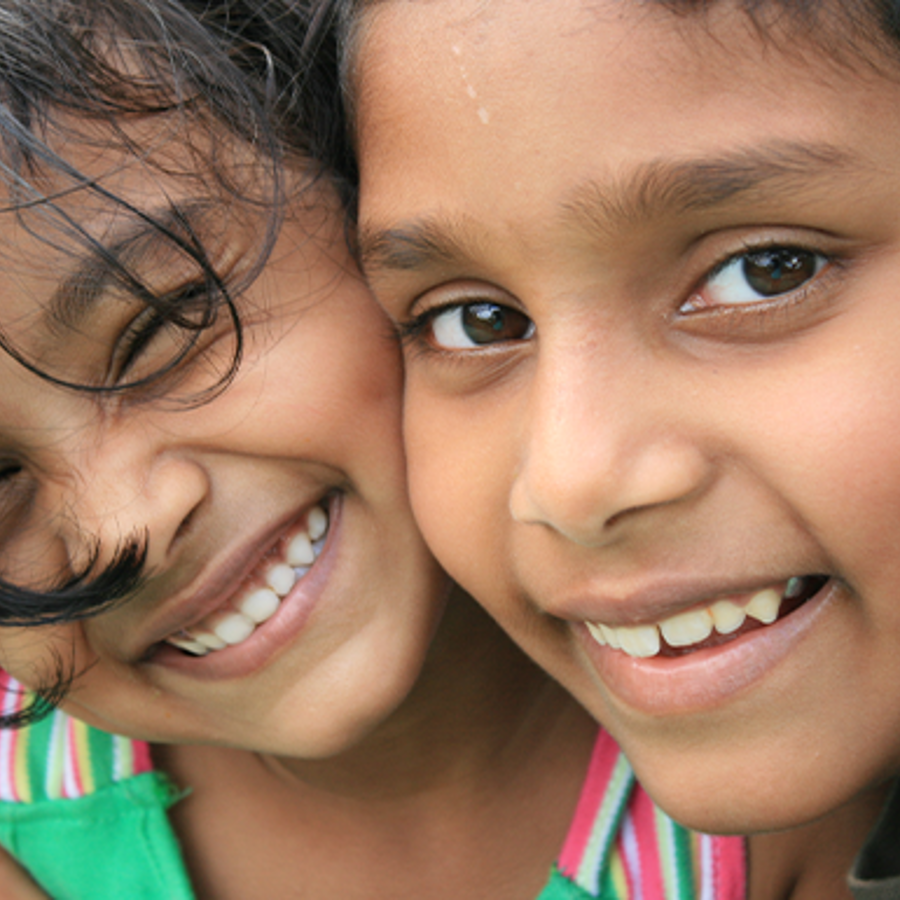
Why do my brother and I share 38% DNA, instead of 50%?
August 2, 2017

- Related Topics:
- Ancestry tests,
- Consumer genetic testing,
- Relatedness,
- Common questions
A curious adult from the US asks:
"My brother and I recently used the DNA testing company MyHeritage and the results said we shared 38% of our DNA. We are confused because we thought full siblings shared 50% and half siblings shared 25% of their DNA. Why are we right in the middle?"
In this case you are almost certainly full siblings. Because of how this (and many other companies) calculate shared DNA, that 38% number is actually equivalent to 50%. In other words, the two of you do share around 50% of your DNA.
It turns out that there are two different ways to count the DNA shared by two people, which mainly only affects how the numbers for full siblings are reported.
Basically, it has to do with the regions of DNA that some companies call “fully identical”.
- Method 1: Fully identical regions are counted twice. When you count this way, full siblings share ~50%.
- Method 2: Fully identical regions are counted once. Counted this way, full siblings share ~38%.
This second method is actually more common, and is what MyHeritage (and many other companies) reports. So in this case, 38% can really equal 50%!
Let’s take a deeper look.
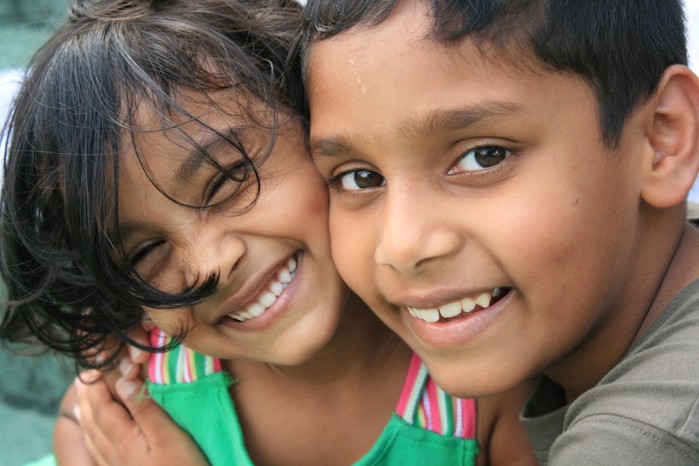
Half Your DNA From Each Parent
You have probably heard that we get half our DNA from our mom and half from our dad. That is why we are usually around 50% related to each of them.
To make things a bit simpler (hopefully!), let’s represent the DNA with rectangles. Here are mom and dad:
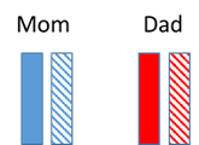
I have colored mom in blue and dad in red just to make tracking simpler.
The first thing to notice is that each parent has two rectangles. This is because all of us essentially have two copies of our DNA. Each copy is a bit different which is why one rectangle is a solid color and the other has stripes. (And also a big reason why we aren’t all exactly alike!)
When we have kids, we pass down one rectangle’s worth of DNA. That is how generation after generation people keep two copies of their DNA—they get a complete copy or rectangle from each parent.
Let’s see what these parents’ first kid might look like:
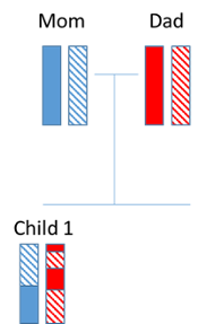
Notice that this child is 50% related to each parent. The child has half red DNA from dad and half blue DNA from mom.
The other thing to notice is that neither mom nor dad passed down a solid or a striped rectangle. Instead they each passed a mix of their two copies of DNA. This DNA swapping process is called recombination (and is another reason we are all unique).
OK now let’s add their second child:
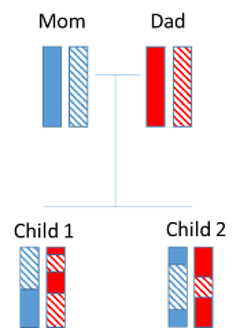
Child 2’s DNA is also made up of half of mom’s and half of dad’s DNA. But these siblings did not get the same DNA from mom and dad. This is why siblings are not exactly alike despite having the same parents.
So these siblings are each 50% related to their parents. And as you’ll see, they are usually around 50% related to each other as well. Even when your testing company says you only share 38% of your DNA.
Sibling Comparison
OK now we are ready to tackle your question.
Let’s focus in on child 1 and child 2. We want to figure out how much DNA the two of them share with each other.
To make things a bit easier to see, I will compare the DNA they got from mom and the DNA they got from dad like this:

On the left we have the two children’s DNA. Blue is from mom and red from dad. On the right, I am comparing the DNA each got from mom and each got from dad.
Here is just the right part of the image:
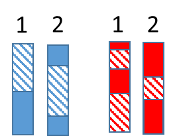
The first rectangle is the DNA child 1 got from mom, the second rectangle is the DNA child 2 got from mom, the third rectangle is the DNA child 1 got from dad and the fourth rectangle is the DNA child 2 got from dad. We are comparing the DNA they got from mom in blue and the DNA they got from dad in red.
Now I will add boxes to show the regions where the two siblings share DNA:
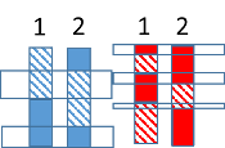
So for example, they share a chunk of mom’s blue striped DNA (the first box in the middle on the left) and a chunk of mom’s solid DNA (in the bottom box). Notice also that in some areas, like the top of the blue rectangles, they do not share DNA.
If we tally this up, we will probably get around 50% shared DNA. Here it might be a bit more or less than that but keep in mind that this is just an example. Real life is more complicated.
In real life, each rectangle is split up into 23 long stretches of DNA called chromosomes. These chromosomes come in pairs which is why we have 46 of them — 23 pairs. (And why the DNA testing company 23andMe came up with their name.)
Because the DNA is spread out over 46 chromosomes instead of just one, things tend to even out more. Sort of like flipping a coin 5 times vs. 5000 times.
With 5 times the odds aren’t too bad that you’d get 5 heads. Something like 1 in 32.
The same isn’t true for 5000 heads in a row. Now we are talking about such high odds that it essentially won’t happen. That is why things tend to even out to more like 50% for siblings.
OK back to the question. Let’s see how companies tally the results.
How Companies Tally Up Shared DNA
All right so here is our comparison again:
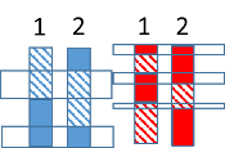
It is important to keep in mind that this is not what the companies “see” in your DNA. Instead they have a mix where all four are in a tube at the same time.
This can lead to different ways of looking at the results. Which is why 38% can sometimes be equal to 50%.
The key difference has to do with the highlighted box here:
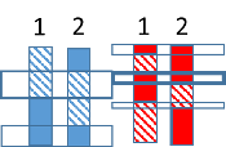
Companies that end up with full siblings sharing 38% of their DNA can’t see the shared red DNA in the highlighted box because it overlaps with the shared blue DNA. In other words, its calculations leave out the red DNA. Companies that report back 50% between siblings can see both boxes and so they count the red in their calculations.
This is why companies give different numbers for the same result.
Here, for example is a set of 23andMe data:
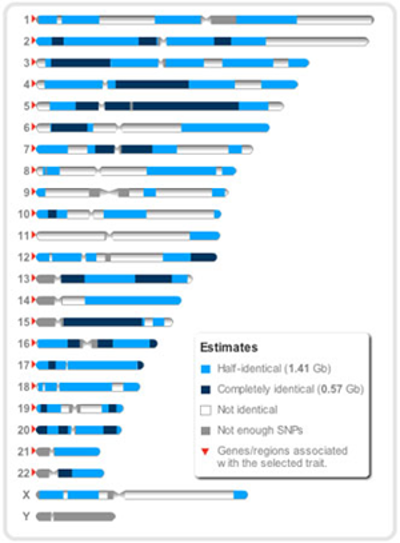
I won’t go into too much detail about this image (although if you are interested, click here). Just pay attention to the colors.
The white are regions where no DNA matches, the light blue is where DNA matches on one pair of chromosomes but not the other pair and the dark blue is where there is a match on both pairs of chromosomes. (We can ignore gray as that is unreadable and/or not covered in their test.)
Here is what they correspond to on my image:
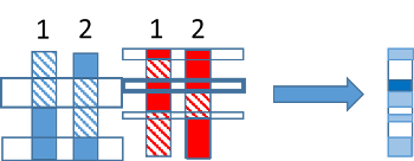
The rectangle on the right is all four chromosome comparisons squished into a single image. White means none is shared, light blue means it is shared only between mom’s or dad’s DNA and dark blue means it is shared on both mom’s and dad’s DNA.
Companies that report 38% only see blue and white in this image. They don’t distinguish between the dark and the light blue. Companies that report 50% can see the different shade of blue and so know that there is extra DNA shared.
Read More:
-
An interactive chart that helps you interpret your shared DNA numbers (which would also show 38% for a sibling)

Author: Dr. D. Barry Starr
Barry served as The Tech Geneticist from 2002-2018. He founded Ask-a-Geneticist, answered thousands of questions submitted by people from all around the world, and oversaw and edited all articles published during his tenure. AAG is part of the Stanford at The Tech program, which brings Stanford scientists to The Tech to answer questions for this site, as well as to run science activities with visitors at The Tech Interactive in downtown San Jose.
 Skip Navigation
Skip Navigation
